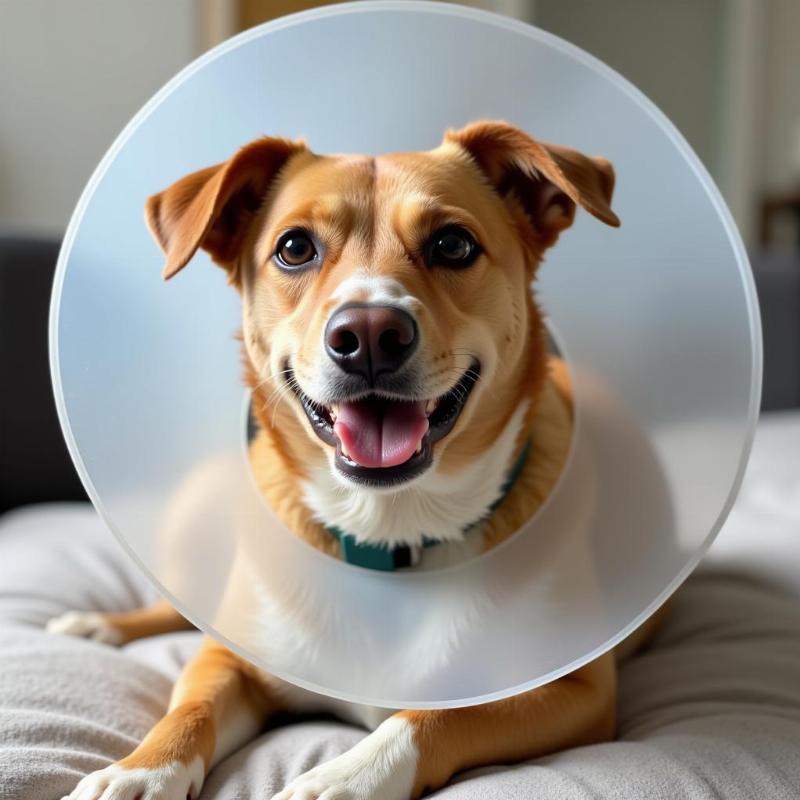If you’ve discovered a hard lump under your dog’s spay incision, it’s understandable to be concerned. This is a relatively common occurrence post-surgery and can range from harmless to requiring veterinary attention. This article will delve into the potential causes of a hard lump under spay incision dog, when to seek veterinary care, and tips for ensuring a smooth recovery for your furry friend.
While some minor swelling and firmness around the incision site are typical during the initial healing phase, a distinct, hard lump warrants further investigation. Understanding the various reasons behind these lumps can help alleviate your worries and guide you in providing the best care for your pet.
Possible Causes of a Hard Lump Under Spay Incision
Several factors can contribute to the formation of a hard lump under a dog’s spay incision. Let’s explore the most common ones:
Seroma Formation
Seromas are pockets of fluid that can accumulate under the skin after surgery. They feel like firm, fluid-filled lumps and are typically benign. While seromas often resolve on their own, larger ones may require drainage by a veterinarian.
Surgical Suture Reactions
Sometimes, a dog’s body can react to the sutures used during the spay procedure. This reaction can cause inflammation and the formation of a hard lump known as a suture granuloma. In most cases, these granulomas are harmless and will eventually disappear.
Infection
Though less common, an infection at the incision site can also lead to a hard lump accompanied by redness, swelling, discharge, and pain. Infection requires prompt veterinary treatment to prevent further complications.
Hernias
In rare instances, a hernia can develop at the spay incision site. This occurs when the abdominal muscles weaken, allowing internal organs to protrude through the opening. Hernias typically appear as soft, squishy lumps that may increase in size with exertion.
When to Seek Veterinary Care
While not all hard lumps require immediate veterinary attention, it’s crucial to monitor the situation closely. Consult your veterinarian if:
- The lump is growing rapidly.
- The area is painful, red, or swollen.
- There’s discharge from the incision.
- Your dog is lethargic, has a fever, or shows signs of discomfort.
- The lump persists for more than a few weeks.
Tips for Post-Spay Recovery
Ensuring a smooth recovery after a spay procedure is essential for your dog’s well-being. Here are some helpful tips:
-
Prevent licking and chewing: Use an Elizabethan collar (cone) to prevent your dog from licking or chewing the incision site, which can disrupt healing and introduce infection.
-
Restrict activity: Limit your dog’s exercise and activity for the duration recommended by your veterinarian. This usually involves short leash walks and avoiding strenuous play.
-
Monitor the incision: Regularly check the incision for any signs of infection or complications, such as redness, swelling, or discharge.
-
Follow medication instructions: Administer any prescribed pain medication or antibiotics as directed by your veterinarian.
 Chó đeo vòng cổ chữ E
Chó đeo vòng cổ chữ E
Conclusion
A hard lump under your dog’s spay incision can be concerning, but understanding the potential causes and knowing when to seek veterinary care can ease your worries. By following post-operative care instructions and monitoring the incision closely, you can help your furry companion recover quickly and comfortably. Don’t hesitate to contact your veterinarian if you have any concerns about your dog’s healing progress.
FAQ
- How long is it normal for a spay incision to be hard? Some firmness around the incision is normal for a few weeks, but a distinct, hard lump should be checked by a vet.
- Can I massage the lump? No, do not massage the lump. This could irritate the area or cause further complications.
- Are seromas painful for dogs? Seromas are usually not painful, but they can become uncomfortable if they grow very large.
- How are suture granulomas treated? Most suture granulomas resolve on their own. Occasionally, surgical removal is necessary.
- What are the signs of an infected spay incision? Redness, swelling, discharge, pain, and lethargy are common signs of infection.
- How long does it take for a spay incision to fully heal? Complete healing typically takes about 10-14 days, but it can vary.
- When can my dog resume normal activity after being spayed? Follow your veterinarian’s recommendations, which typically involve gradually increasing activity over several weeks.
Beautdogs.us is your trusted resource for comprehensive dog care information, breed insights, and premium products. Catering to both new and seasoned dog owners, we’re dedicated to helping you provide the best care for your canine companion. For expert advice and support, reach out to us at [email protected] or call us at +1 501-555-7529. Learn more at Beautdogs.us.